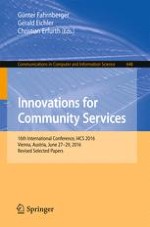2016 | Book
Innovations for Community Services
16th International Conference, I4CS 2016, Vienna, Austria, June 27-29, 2016, Revised Selected Papers
Editors: Günter Fahrnberger, Gerald Eichler, Christian Erfurth
Publisher: Springer International Publishing
Book Series : Communications in Computer and Information Science
